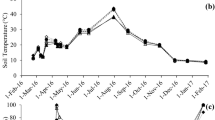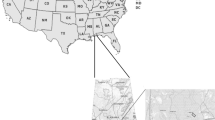Abstract
In the early 1900s, old-growth baldcypress (Taxodium distichum) was completely logged out of what is now the Manchac Wildlife Management Area, located in the Lake Pontchartrain Basin, Louisiana. Natural regeneration of swamp did not occur; the area is currently dominated by bulltongue (Sagittaria lancifolia) marsh. This study was conducted to isolate the major factors prohibiting cypress restoration. Specifically, four hundred baldcypress seedlings were planted in a three-way factorial treatment arrangement that included nutrient augmentation (fertilized vs. unfertilized), management of entangling vegetation (managed vs. unmanaged), herbivore protection (Tubex tree shelters, PVC sleeves, Tanglefoot), and elevation (included as a covariable). Highly significant differences in diameter growth were found for all main effects. For the herbivore protection treatment, relatively inexpensive PVC sleeves were as effective as Tubex Tree Shelters; unprotected trees experienced 100% mortality. Seedlings that received Osmocote 18-6-12 fertilizer showed nearly a two-fold increase in diameter growth. Similarly, seedlings that were managed grew nearly two times greater in diameter than unmanaged seedlings. However, seedlings that wereunmanaged grew nearly two times greater in height than managed seedlings. This study indicates that biotic factors are primarily responsible for the lack of cypress regeneration in southeastern Louisiana, not the prevalent, but largely untested, hypothesis of salt-water intrusion. Moreover, it is likely that, with a combination of management techniques, it is possible to restore swamp habitat in this area. Though labor intensive in the short run (i.e., first few years), once established, these trees may survive for hundreds of years.
Similar content being viewed by others
Literature Cited
Aust, W. M. 1989. Abiotic functional changes of a water tupelobaldcypress wetland following disturbance by harvesting. Ph.D. Dissertation. North Carolina State University Raleigh, NC, USA.
Blair, R. M. and M. J. Langlinais. 1960. Nutria and swamp rabbit damage toTaxodium distichum seedlings. Journal of Forestry 58: 388–389.
Brandt, K. and K. C. Ewel. 1989. Ecology and management of cypress swamps: a review. Florida Cooperative Extension Service Institute of Food and Agricultural Sciences, University of Florida, Gainesville, FL. USA. Bulletin 252.
Brantley, C. G. and S. G. Platt. 1992. Experimental evaluation of nutria herbivory on baldcypress. Proceedings of Louisiana Academy of Sciences 55:21–25.
Brown, S. L. 1981. A comparison of the structure, primary productivity, and transpiration of cypress ecosystems in Florida. Ecological Monographs 51:403–427.
Chabreck, R. H. 1972. Vegetation water, and soil characteristics of the Louisiana coastal region. LA Agricultural Experiment Station. Baton Rouge, LA, USA. Bulletin 664.
Cockerham, W. J., R. E. Dance, A. G. White, and B. E. Spicer. 1973. Soil survey of St. James and St. John the Baptist Parishes. Louisiana. U.S. Department of Agriculture Soil Conservation Service and Louisiana State University Agricultural Experiment Station. Baton Rouge, LA, USA.
Conner, W. H. 1988. Natural and artificial regeneration of baldcypress in the Barataria and Lake Verret Basins of Louisiana. Ph.D. Dissertation. Louisiana State University, Baton Rouge, LA, USA.
Conner, W. H. and G. R. Askew. 1993. Response of baldcypress and loblolly pine seedlings to short-term saltwater flooding. Wetlands 12:230–233.
Conner, W. H. and M. Brody. 1989. Rising water levels and the future of southeastern Louisiana swamp forests. Estuaries 12:318–323.
Conner, W. H. and J. W. Day, Jr. 1992a. Diameter growth ofTaxodium distichum (L.) Rich. andNyssa/aquatica L. from 1979–1985 in four Louisiana swamp stands. American Midland Naturalist 128:237–245.
Conner, W. H. and K. Flynn. 1989. Growth and survival of baldcypress (Taxodium distichum (L.) Rich.) planted across a flooding gradient in a Louisiana bottomland hardwood forest. Wetlands 9:207–217.
Conner, W. H. and J. R. Toliver. 1987. Vexar seedling protectors did not reduce nutria damage to planted baldcypress seedlings. Tree Planters’ Notes 38:26–29.
Conner, W. H., J. R. Toliver, and G. R. Askew. 1993. Artificial regeneration of baldcypress in a Louisiana crayfish pond. Southern Journal of Forestry 17:54–57.
Conner, W. H., J. R. Toliver and F. H. Sklar. 1986. Natural regeneration of baldcypress (Taxodium distichum (L.) Rich.) in a Louisiana swamp. Forest Ecology and Management 14:305–317.
Cornier, E. S., K. K. O’Hara, Jr., and C. M. Capello. 1989. Louisiana water quality data summary 1982–1983. LA Department of Environmental Quality, Baton Rouge, LA, USA.
Day, F. P. and J. P. Megonigal. 1993. The relationship between variable hydroperiod, production allocation, and belowground organic turnover in forested wetlands. Wetlands 13:115–121.
Dicke, S. G. and J. R. Toliver. 1990. Growth and development of baldcypress/water-tupelo stands under continuous versus seasonal flooding. Forest Ecology and Management 33/34:523–530.
Greene, M. 1994. The interacting effects of allogenic and autogenic agents on selected swamp and freshmarsh vegetation. M. S. Thesis. Southeastern Louisiana University, Hammond, LA, USA.
Grime, J. P. 1979. Plant Strategies and Vegetation Processes. John Wiley, New York, NY, USA.
Hammer, D. A. 1992. Creating Freshwater Wetlands. Lewis Publishers. Chelsea, MI, USA.
Kinler, N. and P. Coreil. 1992. Nutria and Muskrat Symposium. Louisiana State University Agricultural Center, LA Cooperative Extension Service, Baton, Rouge, LA, USA.
Kozlowski, T. T. 1984. Responses of woody plants to flooding. p. 129–163. In T. T. Kozlowski (ed.) Flooding and plant growth. Academic Press. New York, NY, USA.
Llewellyn, D. W. and G. P. Shaffer. 1993. Marsh restoration in the presence of intense herbivory: the role ofJusticia lanceolata. Wetlands 13:176–184.
Mancil, E. 1980. Pullboat logging. Journal of Forestry History July: 135–141.
Megonigal, J. P. and F. P. Day. 1992. Effects of flooding on root and shoot production of baldcypress in large experimental exclosures. Ecology 73:1182–1193.
Mendelssohn, I. A. and K. L. McKee. 1988.Spartina alterniflora die-back in Louisiana: time-course investigation of soil waterlogging effects. Journal of Ecology 76:509–521.
Pezeshki, S. R. 1990. A comparative study of the response ofTaxodium distinchum andNyssa aquatica seedlings to soil anaerobiosis and salinity. Forest Ecology and Management 33/34:531–541.
Platt, S. G. 1988. A checklist of the flora of the Manchac Wildlife Management Area, St. John the Baptist Parish. Louisiana. Proceedings of Louisiana Academy of Sciences 51:15–20.
SAS Institute, Inc. 1993. SAS User’s Guide: Statistics, Version 5 edition. Cary, NC, USA.
Shaffer, G. P., C. E. Sasser, J. G. Gosselink, and M. Rejmanek. 1992. Vegetation dynamics in the emerging Atchafalaya Delta, Louisiana, USA. Journal of Ecology 80:677–687.
Steel, R. G. D. and J. H. Torrie. 1980. Principles and Procedures of Statistics: a Biometrical Approach. McGraw-Hill, New York, NY, USA.
Wicker, K. M., D. Davis, M. DeRouen, and D. Roberts. 1981. Assessment of extent and impact of saltwater intrusion into the wetlands of Tangipahoa Parish, Louisiana. Coastal Environments, Inc, Baton Rouge, LA, USA.
Williston, H. L., F. W. Shropshire, and W. E. Balmer. 1980. Cypress Management: A Forgotten Opportunity. U. S. Department of Agriculture Forestry Service, New Orleans, LA, USA. Forestry Report SA-Fr 8.
Author information
Authors and Affiliations
Rights and permissions
About this article
Cite this article
Myers, R.S., Shaffer, G.P. & Llewellyn, D.W. Baldcypress (Taxodium distichum (L.) Rich.) restoration in southeast Louisiana: The relative effects of herbivory, flooding, competition, and macronutrients. Wetlands 15, 141–148 (1995). https://doi.org/10.1007/BF03160667
Received:
Revised:
Accepted:
Issue Date:
DOI: https://doi.org/10.1007/BF03160667




